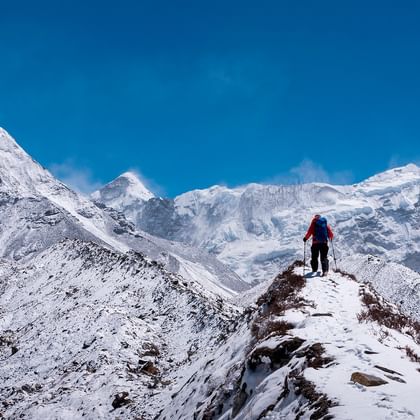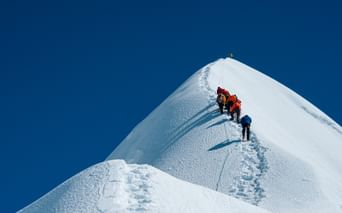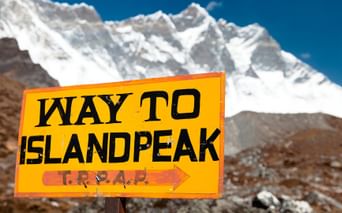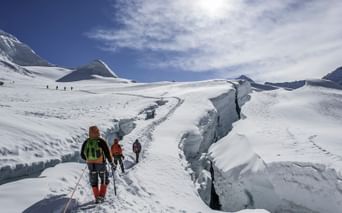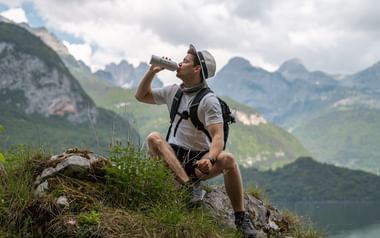Pictures from the trip



Itinerary
When you arrive in Kathmandu, you'll be met at the airport and transferred to your hotel. After resting, you can explore the Thamel area of Kathmandu, which is a tourist hub. If you arrive early enough, you'll receive a briefing on the day's tour. If you arrive late, you will receive a briefing on day two.
Hotel (example): Kathmandu Garden Home
Today there will be a guided tour to two famous temples. The Hindu Pasupatinath and the Buddhist Buddhnanath. In the morning, you'll be met by a local guide and after a delicious breakfast you'll be shown around the city. The Hindu temple of Pasupatinath, dedicated to the god Shiva, is located on the banks of the sacred Bagmati River. Built in pagoda style with beautifully carved silver doors, it is one of the holiest temples in Hindu culture. Pasupatinath Temple is the destination for Hindu pilgrims from all over the world during Shivartri. Only Hindus are allowed to enter the temple's central courtyard. Tourists have to “settle” for viewing the temple from the opposite bank of the Bagmati River.
Next stop is the Buddhist temple of Bouddhanth, which is the largest stupa (Buddhist earthen mound) in South Asia and the center of Buddhism in Nepal. The ancient and colossal stupa was built in the 6th century by King Man Dab of the Lichhabi dynasty. The stupa rests on three large terraces, and from above it has the shape of a lotus flower, which is a very sacred flower for Buddhists all over the world.
Guided tour: 4-5 hours
Hotel (example): Kathmandu Garden Home
The day starts at 1am with a transfer to Ramechhap Airport. Here, an early morning flight to Lukla awaits. From Lukla you fly the short but incredibly beautiful route to Lukla, which is 2804 meters above sea level. Upon arrival, you'll have time to explore the village while the guides load your trekking gear. You'll then begin your trek by descending to the Dudh Kosi River, then follow the route to Namche Bazaar, located just above Chaunrikharka (2713m). It's an easy walk and after passing the small village of Ghat (2550m), it's only a short distance to Phakding.
Driving time: approx. 4 hours
Flight time: Approx. 20-30 min.
Hiking: approx. 3.5 hours
Hotel (example): Teahouse
Continue trekking along the banks of the Dudh Kosi River, crossing the river several times using exciting suspension bridges covered with prayer flags. As you enter Sagarmatha National Park, the trails become steeper with stunning views. Before you reach Namche Bazaar, weather permitting, you'll be able to see Mount Everest! Namche Bazaar is best known as “The Gateway To Everest”, and here you'll find many great restaurants, lodges, shops, money changers, internet cafes and bakeries. Namche Bazaar is one of the largest villages along the Everest route.
Hotel (example): Teahouse
You'll spend the whole day in Namche Bazaar to acclimatize to the incipient thin air. The day isn't all relaxation, however, and you'll take a short trip to the local museum, where the traditional customs of the Sherpa people are celebrated. From the museum you can see Mount Everest on the horizon. You can also choose to hike up to the old Syangboche airport near Everest View Hotel. From here you'll experience incredible views of the Himalayas and stunning sunrises and sunsets over the Khumbu peaks.
A good way to spend your acclimatization day in Namche Bazaar is to hike up to the Khunde Hospital, where the route was laid out by Sir Edmund Hillary himself (the first person to climb Mount Everest, which he did together with Sherpa Tenzing Norgay). Another great idea would be to trek up to Tengboche (3800m), where the Everest View Hotel offers stunning views of Everest, Nuptse, Lhotse, Ama Dablam, Thamserku and Kusum Kangaru.
Hotel (example): Teahouse
The trek from Namche Bazaar leads up to the picturesque village of Khumjung. Khumjung is the largest Sherpa village in the Khumbu region. The village has fine sights, such as the Khumjung Monastery, which sits on top of a hill and houses a preserved skull, which the locals believe belongs to a Yeti. Here you'll also find the Hillary School, which was inaugurated in 1961 and has played an important role in providing education to the children of the area. It is part of the Hillary Himalaya Foundation, which continues to support education and health projects in the region. The school is seen as a symbol of the positive impact that mountaineers have had on the local Himalayan community.
You'll arrive in Khumjung for lunch, giving you time to explore the village.
Hotel (example): Teahouse
After breakfast, you'll hike gently up the hill to the beautiful spot of Mong La, from where you can enjoy stunning views of the mountains. Then start the descent to Phortse Thanga. The trail down to Tenga is beautiful and takes you through the rhododendron forest, which blooms in spring. You can observe a variety of wildlife here, including Himalayan Thar (mountain goat), deer, Himalayan Monal (pheasant) and other game. From Phortse Thanga you'll gradually ascend until you reach Dole, where you'll spend the night.
Hotel (example): Teahouse
Today you'll continue to Machermo, which will take around 4.5 hours. From Dole, the route climbs along the valley, and as you ascend, the small thorny bushes are replaced by juniper bushes. The route passes through several different small communities and offers views of the Cho Oyu, Kantega and Thamserku mountains. This is a short day and you'll arrive in Machermo in time for lunch in town.
Hotel (example): Teahouse
Today you'll head towards the Gokyo Lakes via the beautiful route to Pangka and from there down towards the rivers of meltwater flowing down from the Ngozumpa Glacier. You'll climb down a steep cliffside into the valley next to the glacier and the first of the sacred lakes. You'll quickly reach another sacred lake and then follow the route to Lobuche. The third lake you come to is called Dudh Pokhari and on its shores lies the town of Gokyo, one of the most beautiful places on the tour.
Hotel (example): Teahouse
Another truly beautiful day awaits you. You start early in the morning to experience the sunrise. You move along the narrow path to Gokyo Ri (a mountain peak). As you ascend, the peaks of Mt. Everest, Lhotse and Makalu slowly come into view. The hike to Gokyo Ri is well worth it and the views of the Gokyo Valley, Ngozumpa Glacier and the Khumbu region of the Himalayas are stunning. You'll then trek to Thangnak, where you'll spend the night.
Hotel (example): Teahouse
This is another big day. You'll get an early start with a pre-dawn trek, weather permitting, before beginning today's trek. The trek ascends to the foot of Cho La Pass, climbing gradually up a slope. From the foot of the pass, you'll have to negotiate the steepest part of the route on this trek to get over the Cho La Pass. It's a physically demanding day, and the hike is far from over at the top. You then move along the long rocky path to Dzongla, where you spend the night. Just before Dzongla you have a good view of Cholaste, Ama Dablam and Lobuche.
Hotel (example): Teahouse
After the hard stages of the previous days, this day offers a shorter trek. You walk and observe the beautiful landscape of mountains and lakes. As you pass the yak grazing land at Lobuche, it opens up again to a panoramic view, a mountain view you never get tired of. When you reach Lobuche, you'll rest for the rest of the day.
Hotel (example): Teahouse
A long and challenging trek awaits you today along the Khumbu Glacier and up to Everest Base Camp at an altitude of just under 5,400 meters. This is the closest you can get to Mount Everest without carrying climbing equipment. It's highly likely that there will be a climbing team at the base preparing for a trip to the summit. The view of Khumbu Icefall from the base is amazing! After enjoying the view and the experience, you will return to Gorak Shep, where you will spend the night.
Hotel (example): Teahouse
Before breakfast, you'll climb to the top of Kala Patthar. The distance isn't long, but you'll take it at a leisurely pace to adjust to the altitude. Reaching the summit (5545m) is challenging, but the views from there will surpass all your wildest fantasies. You'll see huge glaciers and mountains everywhere, and the only thing that breaks the silence is the cracking of the glacier. The mountains you can see from here include Pumori (7,145m), Lingtren (6,697m) and Khumbutse (6,623m). You can see all the way to Tibet from here. You'll then descend to Gorakshep for breakfast before hiking down to Lobuche where you'll spend the night.
Hotel (example): Teahouse
Today is a quiet day. You go to Dingboche and on to the Chhukung Valley along the Imja River. Here, another fantastic view of the huge mountains awaits. It's particularly spectacular to see the massive south face of Lhotse and the beautiful Ama Dablam mountain on either side of Island Peak. You'll arrive in Chukung well before lunch, and after lunch there's time to prepare your climbing gear and have a look around.
Hotel (example): Teahouse
The trail from Chukkung goes very steeply south and then turns east to be in line with the valley. The trail then meanders until you reach the “Big Rock”. You move over glaciers until you reach the south side of Island Peak. Here you'll spend the rest of the day training for the climb.
Hotel: Tented camp at Island Peak Basecamp
You'll start climbing early in the morning, around 1-2am. From Base Camp you walk towards High Camp. Here you'll encounter stone steps leading up to a mountain ridge. From here there are good views to the top. Since the rocks are a big challenge here, the guides will secure you with ropes. With the support and guidance of the Sherpas and the team as a whole, you'll work your way up to the top of Island Peak. Once you reach the top, you can enjoy the stunning views of the world as if you were standing on the edge of it. After taking some photos, both physically and mentally, and enjoying the rush of standing on top, the descent begins. You'll continue past Base Camp and hike all the way down to Chhukung.
Hotel (example): Teahouse/tent camp
If you had to spend an extra night in the tent camp at Base Camp yesterday due to the weather, today you have another chance to reach the summit.
If your trek went as planned yesterday, you can use this day to continue your descent towards Lukla, thus shortening some of the coming days' trek.
Hotel (example): Tea House
The route leads you gradually downhill among juniper bushes and Mani stones to Pangboche. The gompa in Pangboche is the oldest in Khumbu and definitely worth a visit. You continue down to the valley, where the trail narrows and leads you through alpine meadows, eventually arriving at Tengboche, home to the Khumbu region's largest monastery.
Hotel (example): Tea house
You leave Tengboche from the back of the monastery and continue down until you reach Phunki Tenga. From here, the trail climbs through a forest, and when you emerge from the forest, you walk along a mountain ridge with views down into deep gorges. You finish the day's trek with a steep climb up to Namche Bazaar, a walk through a narrow gorge and finally a short ascent to the village of Monjo.
Hotel (example): Teahouse
You'll walk back to Lukla along the same route as when you started the hike. It's the same, but it never looks quite the same when you go the opposite way. Once in Lukla, you'll have time to relax and celebrate the completion of your long trek. This is also where you say goodbye to your skilled guides, porters and assistants.
Hotel (example): Teahouse
You'll take a morning flight to Ramechhap. Be sure to enjoy the majestic mountains from the air on this short trip. From Ramechhap, you'll be transferred to Kathmandu, where you can relax for the rest of the day.
Flight time: approx. 20-30 min.
Driving time: approx. 4 hours.
Hotel (example): Kathmandu Garden Home
(This is a reserve day in case of unforeseen weather problems/canceled flights from Lukla).
If your trip has gone according to plan, this day will be used for a guided walking tour of Kathmandu.
On this walk, we'll explore the local market Ason, the pearl market Indrachowk, the oldest supermarket - New Road and the Hidden Stupa. After discovering these little gems of Kathmandu, we'll head to Kathmandu Durbar Square, known for its unique historical, cultural and religious traditions. A special experience awaits here with a visit to the temple of the living goddess “Kumari”.
The Durbar Square walk is a perfect blend of culture, history, art, architecture and traditional values prevalent in the Kathmandu Valley. After the walk, you'll have time on your own to shop for the latest souvenirs or simply enjoy the atmosphere of the city.
Overnight at a hotel in Kathmandu.
Duration of the guided tour: 4-5 hours
Hotel (example): Kathmandu Garden Home
Today is the last day in Nepal. You are transferred to the airport in time to catch your flight home.
Prices and dates
The price includes
- A highly experienced local alpine mountain guide, as well as porters for the transportation of baggage during the trek.
- All accommodations during the trek (tea houses, lodges, tents)
- 3-star hotel in Kathmandu incl. breakfast
- All meals during the trek
- Hot drinks 3 times pr. day (tea, coffee, cocoa)
- Transfer from/to the airport
- All land transportation
- Information meeting with our team upon arrival in Kathmandu
- Local flights (Ramechhap - Lukla – Ramechhap)
- Guided sightseeing in Kathmandu
- All temple tickets for the sightseeing tour in Kathmandu
- All shared climbing and camping equipment
- Possible rental of missing personal climbing gear
- Free loan of sleeping bag and down jacket if needed
- TIMS (Trekkers Information Management System)
- All necessary trekking permits
- Food, lodging, above average salary, insurance, medical equipment, flights, and land transport for the Nepalese staff
- All taxes
- 24-hour local and international service hotline for the duration of the tour
- This is a packaged holiday and is therefore covered by The Travel Guarantee Fund - See which benefits this means for you - click here
- Flights to/from Kathmandu
- Visa to Nepal (remember to bring 3-4 passport photos)
- Lunch and dinner in Kathmandu
- Personal trekking equipment
- Tips (expect around 150-200 USD pr. person
- Travel insurance (you are required to have travel insurance for this holiday - but you are free to choose which one)
- Administration fee (20€ pr. booking)
Practical information
This is an international group tour with a local team of guides, porters, and drivers.
The price is based on a group of a minimum of 2 and a maximum of 10 people.
Participants will share a double room with another participant on the tour.
The tour does not include the flight, which can be purchased only after securing a spot on the tour.
Please note that day 1 in the itinerary is the day you should arrive in Kathmandu, which typically means the flight departs from overseas one day earlier.
Dates:
This tour is scheduled as an international group tour with English as the common language in 2024, offering two possible start dates:
- Spring ascent starting on March 21.
- Autumn ascent starting on October 12.
It is also possible to request an offer for the tour for a private group of a minimum of 2 people on any chosen start date. The spring tour can start from March to early May, while the autumn tour can start on any day in October.
Check the price quickly
You can quickly check the price of your desired trip without having to fill in anything. Here's how:
- Choose your desired start date
- Click on the green button "See price and reserve your holiday" and go to the booking form
- Select number of people, add any optional extras and see the price at the bottom of the page (you don't have to fill in anything on the form).
Get a quote
For example, if you want a flight included or changes to the trip, you can order a quote for this using the "Get a quote" button. Remember to describe in detail what, if anything, you want changed.
The process of your booking
When you book, we will start booking hotels and arranging all the practical details of the trip. This process typically takes 2-5 working days, but some bookings may take longer. If you are arranging your own transport, we recommend that you wait until we have confirmed your booking before arranging this.
The flights to/from Kathmandu are not included in the price. You can easily find a suitable flight via a flight booking engine such as Momondo or Skyscanner.
Notice: This is a group tour which requires a minimum number of participants. We urge you to wait with booking your flight until you have recieved the final confirmation from us. We will confirm two months before depature at the latest.
And when booking fligts remember to check you distance to Kathmandu. You need to arrive Kathmandu on day 1 in the program, that might mean that you need to depart the day before from you country of residence.
Airport transfers
When you arrive at the airport in Kathmandu, you will be picked up and brought to the first hotel. It does not matter what time of day you arrive.
It works like this:
- You book your chosen holiday with us
- We confirm your holiday (usually within 2 business days)
- You arrange your transportation
Get a quote
If you prefer that we handle your flight, then we would be happy to arrange this for you. You simply book a quote below the map on this page and we will return with a quote as soon as possible (usually within 48 working hours). Please note that we add a handling fee of 45 euro to each flight and this means that the flight will be cheaper if you book it yourself.
In Kathmandu you will stay in a tourist class hotel in Thamel. On the trek you stay in teahouses which are guesthouses operated and owned by local families. The quality of the teahouses vary, and we try to book the best possible, but be prepared for primitive conditions. The teahouses often have a common room, which is heated with a stove. You will mostly stay in double rooms and occasionally in multiple-bed rooms with 4-6 beds in each room. The rooms are not heated. You will need a good sleeping bag with a comfort temperature down to -15 degrees Celcius.
At some teahouses it is possible to buy a bath, but be sure to ask whether the water is heated by solar energy, so that we can help to protect the vulnerable forest growth.
On summit days, we will be camping overnight since there are no teahouses at such high altitudes. There are typically two persons per tent.
In Kathmandu, breakfast is included, but you will need to purchase other meals on your own. During the trek, you will receive breakfast, lunch, and dinner. Additionally, you will have hot drinks three times a day. It is customary to eat at the teahouse where you are staying. Lunch is taken along the trek when convenient. The teahouses serve substantial meals, and the menus are generally similar at all teahouses. You can buy bottled water, as well as hot tea, coffee, cocoa, beer, and soft drinks at all teahouses.
On summit days, breakfast, lunch, and dinner are included and prepared under primitive conditions at our tented camp.
A typical trekking day begins with a wake-up call between 6:00 - 6:30 am. After getting dressed and having breakfast, you pack your bags in the equipment bags and start walking around 8:00 am. It's important to go at your own pace and take the breaks you need. In the middle of the day, you take a good, long lunch break before continuing the afternoon trek. You arrive at the accommodation in the late afternoon, and after being assigned your rooms, there is plenty of time to relax, explore the village, talk to the locals or your fellow travelers, or read a good book. Dinner is served between 6:00 - 7:00 pm. Most people choose to go to bed early.
On summit days, you start exceptionally early (around 1-2 am) and have a long day of trekking ahead of you.
This trip is graded 5 and 6.
Grade 5
Longer treks of several weeks, involving sleeping in tents and with daily walks of 6-8 hour in demanding terrain. There can be longer climbs over high passes in altitude around 5.000 meter/17.000 feet. Requires good fitness and endurance ability. Previous trekking experience is recommendable. Requires good hiking boots and regular "outdoor" clothing. There will be major fluctuations in temperatures.
Grade 6
Demanding trekking in difficult terrain. These treks or expeditions often involves crossing glaciers or climbing a peak. You have to be in great shape, and previous experience in demanding mountain terrain is recommendable. These expeditions will take you to high altitude and there can be passages that require the use of ropes and crampons. These treks and climbs challenge your physical limits and the experience of the expeditions can be depending on weather. These demanding treks or expeditions often require equipment like harness, climbing boots and crampons.
Read more about our Grading System
Area: 147,181 km²
Population: Approximately 26 million
Religious Holidays/Festivals
Nepal is primarily a Hindu country, heavily influenced by Buddhism. Therefore, there are many religious holidays. Several of the major holidays fall during trekking seasons and can affect activity levels. Take it easy if things don't go according to plan; everything always works out. Diwali is a major Hindu festival of lights also celebrated by Buddhists, among others. The celebration symbolizes the victory over evil. Diwali also honors the Hindu goddess Lakshmi, who represents prosperity, wealth, and beauty. The festival days vary with the lunar calendar each year. In 2016, Diwali is celebrated in the last week of October.
Electricity
You can charge batteries at lodges and hotels. The power voltage is 240 volts, but it can vary greatly in the mountain areas. It is recommended to bring a multi-plug adapter with several options.
Phone and Internet
Country code: +977
Remember to disable automatic updates, data roaming, etc., on your phone/tablet to avoid a surprisingly large bill when you return home. There is increasingly Wi-Fi in many teahouses in the Annapurna area. There is network coverage in many places during the trekking tour, but it is expensive to call home, so many choose to stay in touch with family via SMS. However, there will be areas where it is not possible to get a connection.
Language
Nepal's official language is Nepali, but many dialects are also spoken. Our local guides speak English well, though usually with an accent. In hotels, teahouses, and shops, English is also spoken well. The porters on the trekking tour do not always speak English very well (and yaks not at all!).
Dress Code
In general, the dress code in Nepal is very relaxed, even at the better hotels. It is important to dress with respect for religion and local customs. Therefore, dress modestly and consider when it is appropriate to wear shorts, especially if you are visiting temples and monasteries. It is good etiquette to have your shoulders and knees covered.
Time Difference
Nepal is 4 hours and 45 minutes ahead of Denmark and 3 hours and 45 minutes ahead of Denmark when we have daylight saving time.
Photography
There are countless photo opportunities in Nepal, so make sure you have enough space on your memory card. Show respect for people and ask for permission before taking pictures of them.
Currency and Price Level
The local currency is the rupee (NPR). In Kathmandu, there are many ATMs where you can withdraw money, as well as exchange offices where you can exchange cash in dollars and euros. We recommend that you withdraw/exchange an appropriate amount for the trekking tour before leaving Kathmandu. Most teahouses only accept rupees as a means of payment. Check www.valutakurser.dk for current exchange rates.
Tips
It is customary to give tips in Nepal. In restaurants, the amount is rounded up to about 10% of the bill. It is also common to tip guides and porters, and you should expect to give approximately 80-120 US dollars in tips per person. A good rule of thumb is that for every 10 USD the guide gets, the porters get 6 USD.
It is the customer’s responsibility to have a valid passport. It is also the customer’s responsibility to seek and obtain any necessary visa for travelling to the booked destination. Your passport must be valid for at least 6 months after the expected return. Note that there may be special visa requirements for different foreign nationalities. Please note that processing time for visas to some countries may be several weeks. Mountain Adventures have no responsibility for any lack of travel documents. Be aware of any transit visa requirements.
We advise you to contact a medical specialist or you personal doctor or a licensed vaccination clinic. Please note that you should bring your vaccination certificate when you travel to Nepal.
We recommend taking out travel insurance that covers at least illness, accident, repatriation, lost holiday, luggage and liability. As a customer, you are responsible for taking out the necessary travel insurance to cover these costs.
Before taking out insurance, you should check whether you are already covered by travel or cancellation insurance through your home insurance company, credit card or similar - please note that there may be differences in insurance coverage.
After booking this trip, you get access to various discount schemes.
The best season for trekking in the Everest region are spring and autumn. March, April, May, October, November and December are great for trekking. It is usually clear weather and bright sunshine in the morning. During the afternoon the evaporation of snow in the mountains forms some clouds, but it usually clear up at sunset. It is also possible to trek in the winter months of January and February, but it can be very cold I high altitude. The summer season from June to the end of September is characterized by the Indian monsoon with a lot rain.
We have listed the personal climbing equipment you will need for the ascent. It is possible to rent all items listed here, and this rental is included in the price of the trip. If you have some of the equipment yourself, please bring it along. It is safe to use your own gear. When borrowing climbing boots/mountaineering boots (plastic), it is important to understand that we cannot guarantee all sizes but will find the best possible boots for you. If there is one thing from the list you want to buy yourself, it should be this. The equipment will be reviewed with the local guide upon arrival in Kathmandu.
- Ice axe
- Crampons
- Climbing boots/Mountaineering boots (plastic)
- Climbing harness
- Brakes (belay device and figure-eight)
- Ascender
- Screw carabiners (4 pcs)
- Climbing slings (2 pcs)
- Climbing helmet (optional but recommended)
Here is no text
Travelling to Nepal is always an adventure and you should be prepared for changes along the way. Bering Travel and our good partners always strive to carry out the trips according to the programme, but there may be local conditions and situations where it may be appropriate to adjust the programme along the way. For example, political or natural conditions may cause the guide to change the programme. It may also be the physical ability of the participants, unsuitable climbing weather or delayed flights that require changes to the programme. An extra day is included for summit attempts to maximise the chances of success. It will always be the main guide's decision whether it is safe to attempt the summit. We and our partners always do our best to execute the promised programme, but we are not master of the weather and wind, so if there are changes along the way, take it as an experience.
